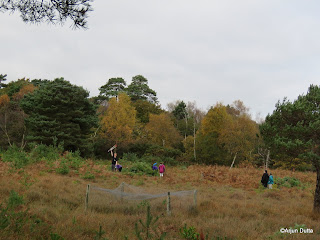After waking up bright and early, I realised I should've gone to sleep earlier than midnight...
However, by 6 I was being awoken by Buzzards and Owls (Tawny and Barn) calling outside very loudly.
We were all downstairs for breakfast by 8am. Then we got ourselves ready, with sturdy boots and thick clothing, ready for some tough work. We left the hostel at 9:15am, where we got on a coach nearby. On the journey there, while I sat half-asleep, most people were already spotting things, with Little Egrets and the occasional Meadow Pipit being seen.
However, by the time we'd arrived at Arne, adrenaline (and Lewis) had finally woken me up and I was ready to get stuck in and see some good-quality wildlife. When dropped off at the car park, we all started looking for things, and of the 6 Firecrest seen that morning in the car park, we saw
On the way there, we saw a couple of Kestrel additional to other small birds.
To start with, we were split up into two. My half started by using saws and large shears/cutting things to chop as many pine trees down as possible - the small trees spread so much in the boggy meadows it was starting to destroy some of the habitat, so we had to cut as many down as possible.
Over an hour, we must have cut just over 100, making the field completely different to before. Once all the trees had been gathered into piles across the field, we made a fire using old sticks from trees, and then stuck them all on, causing smoke to go everywhere (including my mouth.)
 |
| The group at work (with the most entertaining guy Elliot clearly enjoying it!) |
 |
| The fire |
While all that was going on, there was lots to see or hear. (In fact I may as well admit now, none of us saw nor heard the Dartford Warblers, which we were all desperate to see!) There were loads of Curlew calling, and Redpolls and Goldfinches were sometimes flying over. Woodpeckers and thrushes were seen flying around, and also a few buzzards were circling.
After having a lunch, where there were a few Redwing and Fieldfare knocking around, and typically, a few of us heard a Firecrest, but didn't see it, we went back down to the field for another hours work. Except now my group were doing some more horrible, disgusting yet fascinating stuff; clearing out the small boggy ponds of the goo which had gathered at the bottom. Not only did it stink, it was quite dense and hard to remove from the ponds. We were told it was important to clear it out, as the ponds are a vital habitat for a variety of species, with amphibians as well as birds living around them.
 |
| Red Admiral (in late October!) |
 |
| All that area is BOG |
We had a fairly good hour, finding a few Raft Spiders, getting rid of as much muck as possible, and a few near falls into the ponds - and one fall for good measure! With as much done as possible, and Elliot remarkably finding a Sika deer antler, we went back to our bags and got ready to go for a walk back to the coach, while passing the harbour en route.
When we got to a viewing platform, immediately everyone was looking out to see whatever possible. There were: 60 Oystercatcher, 4 Little Egret, 40 Cormorant, c.30 Blackwits and a Redshank, a Curlew, a Whimbrel and 7 Brent Geese in the middle of the harbour- this is full zoom with 260x zoom!
 |
| Oystercatchers |
 |
| Brent Geese |
 |
| Blackwits + Redshank (in middle cove) |
We walked around a bit, and saw some more thrushes and smaller birds. A few more mipits were found miles away, and then we were nearly back. There was almost a reluctant feeling from everyone as we boarded the coach, having to leave a wildlife haven behind.

No comments:
Post a Comment